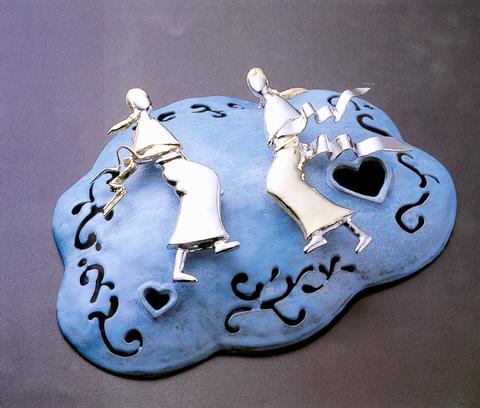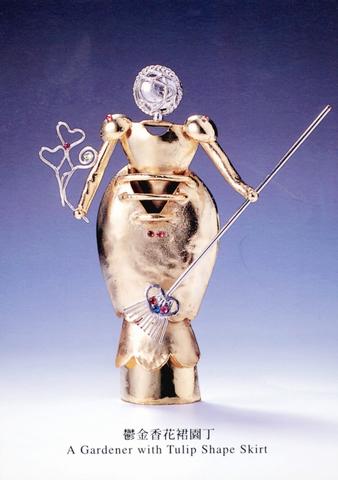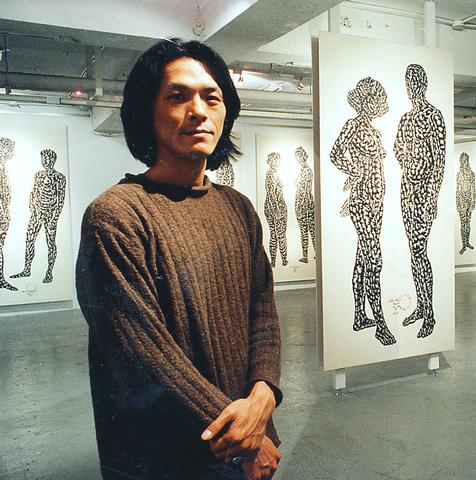Huang Chih-yang has abandoned his grisly `Zoon' series to make portraits of lovers
Ink painting artist Huang Chih-yang (

PHOTO COURTESY OF HANART GALLERY TAIPEI
Reflecting on his older work, Huang said it was the result of an emotionally turbulent time, as he sought, in his own words, to find "the essence of life." He wanted to create his own personal world, with a new species of creature and a different feel of space.

PHOTO COURTESY OF TU CHIA-CHI
What he came up with in his musings were the so-called Zoon figures, which, beyond their menacing appearance, communicate an unmistakable universality. Painted with ink and acrylic on long scrolls of rice paper, these figures are hung imposingly from the ceilings of exhibition spaces.
His new series, with the far more cuddly name of Lovers' Library (

PHOTO COURTESY OF TU CHIA-CHI
Huang created the pieces in New York, Berlin and Taiwan, and invited more than 20 couples to be his models. Peter and Nadja: Punk Lovers and Annette and Alfonso: Painter and his wife, are two examples from the series. The names in their standardized format seem to transcend borders and individuality to communicate a universal sense of human intimacy.

PHOTO COURTESY OF HANART GALLERY TAIPEI
The series has been partially exhibited in Hong Kong, Berlin, and Australia. The Taipei show is the largest ever exhibition of the series, with a selection of 25 ink paintings on silk taken from the portraits of 14 couples.
The exhibition space has been transformed with tall wooden panels into what Huang hopes resembles a labyrinth. His black and white paintings are mounted on the panels, which he says makes the works seem like fossils presented in a museum of anthropology.

PHOTO COURTESY OF TU CHIA-CHI
"Spiritually, Huang is searching for a state of utopia through the project," art critic Johnson Chang (
Tu Chia-chi benda the definition of craft with her metal and jewelry pieces
Crafts and product design have brought art closer to people's daily lives by beautifying many of our most common objects.
Jewelry designer and metal artist Tu Chia-chi (杜嘉琪) makes works that blur the boundary between craft and art and has rented out four windows in a jewelry store to exhibit 50 pieces from two series titled A Garden of Hearts (心情花園) and Dress Forming Language (衣的形象語言).
In her first solo exhibition in six years in Taipei, Tu describes her delicate pieces as "sculpture on the palm of the hand." The sculptures are made of copper and silver decorated with coral, pearl, crystal and stone and are often set on a heart-shaped base. In one piece called The Angel with Heart (捧心天使), the figure is dressed in an exquisite silver gown and has two hollow, heart-shaped wings. Another simple but stunning piece is A Gardener with Tulip-Shaped Skirt (鬱金香花裙園丁), which, despite its title, is more a rendition of Cinderella in a shiny golden dress holding a silver wand.
With a degree in sculpture and further training in the US in metal and jewelry art, Tu says her type of art is still quite rare in Taiwan.
"This kind of art was started in the 1960s in the US, and then gradually moved from craft to fine art. It's a whole new spectrum of experience putting fine daily materials into creative works," said Tu, who teaches metal art and makes jewelry and gifts on commission.
Tu's designs are stylish and feminine, using gardens and princess figures in ravishing dresses. The pieces, she says, reflect her mood and imagination over the past few years.
"Try to put your mind in a story-telling mode and let your imagination run free," Tu says. "Because I have set up a wonderland for you."
Art Notes:
What: Lovers' Library 1998-2000 by Huang Chih-yang (黃致陽 -- 戀人絮語1998-2000)
Where: Hanart Gallery Taipei (漢雅軒), B1, 306, Jen-ai Rd., Sec. 4, Taipei (台北市仁愛路4段306號B1)
When: Until April 22 (Closed Monday)
What: Dress Forming Language: Tu Chia-chi Metal Art Solo Exhibition (衣的形象語言&心情花園)
Where: Lucoral & Lupearl Jewelry, 90, Nanking E. Rd., Sec. 3, Taipei (大東山珠寶一樓蘇活藝術家走廊:台北市南京東路3段90號)
When: Until April 15

Behind a car repair business on a nondescript Thai street are the cherished pets of a rising TikTok animal influencer: two lions and a 200-kilogram lion-tiger hybrid called “Big George.” Lion ownership is legal in Thailand, and Tharnuwarht Plengkemratch is an enthusiastic advocate, posting updates on his feline companions to nearly three million followers. “They’re playful and affectionate, just like dogs or cats,” he said from inside their cage complex at his home in the northern city of Chiang Mai. Thailand’s captive lion population has exploded in recent years, with nearly 500 registered in zoos, breeding farms, petting cafes and homes. Experts warn the

No one saw it coming. Everyone — including the Chinese Nationalist Party (KMT) — expected at least some of the recall campaigns against 24 of its lawmakers and Hsinchu Mayor Ann Kao (高虹安) to succeed. Underground gamblers reportedly expected between five and eight lawmakers to lose their jobs. All of this analysis made sense, but contained a fatal flaw. The record of the recall campaigns, the collapse of the KMT-led recalls, and polling data all pointed to enthusiastic high turnout in support of the recall campaigns, and that those against the recalls were unenthusiastic and far less likely to vote. That

The unexpected collapse of the recall campaigns is being viewed through many lenses, most of them skewed and self-absorbed. The international media unsurprisingly focuses on what they perceive as the message that Taiwanese voters were sending in the failure of the mass recall, especially to China, the US and to friendly Western nations. This made some sense prior to early last month. One of the main arguments used by recall campaigners for recalling Chinese Nationalist Party (KMT) lawmakers was that they were too pro-China, and by extension not to be trusted with defending the nation. Also by extension, that argument could be

Aug. 4 to Aug. 10 When Coca-Cola finally pushed its way into Taiwan’s market in 1968, it allegedly vowed to wipe out its major domestic rival Hey Song within five years. But Hey Song, which began as a manual operation in a family cow shed in 1925, had proven its resilience, surviving numerous setbacks — including the loss of autonomy and nearly all its assets due to the Japanese colonial government’s wartime economic policy. By the 1960s, Hey Song had risen to the top of Taiwan’s beverage industry. This success was driven not only by president Chang Wen-chi’s